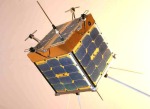On Thursday, November 6 at 07:35:49 UT a Dnepr rocket carrying the primary payload Asnaro-1 and four microsatellites was launched from Dombarovsky near Yasny. Kosmotras report all spacecraft have been inserted into their target orbits.
The four Japanese microsatellites are:
– ChubuSat-1 (Kinshachi-1) 437.485 MHz CW/AX.25 (Digipeater uplink 145.980 MHz)
– TSUBAME 437.250 MHz CW and 437.505 AX.25
– Hodoyoshi-1 467.674 MHz
– QSAT-EOS (Tsukushi) an AX.25 GMSK payload has been reported but the frequency is unknown.
Signals have been received from both ChubuSat-1 and TSUBAME.
The 50kg class ChubuSat-1 aims to
• Relay messages in amateur service (AX.25 packet radio Digipeater)
• Take pictures of particular site on Earth commanded from the Earth station with an optical camera and an Infra-red camera
• Try to take pictures of space debris commanded from the Earth station with above two cameras
It will have 3 axis stabilisation
 The 30kg class TSUBAME aims to
The 30kg class TSUBAME aims to
• Demonstrate satellite bus technology for 30kg-class microsatellite and verification of COTS components such as micro-processors, memory and Li-ion batteries in the space environment
• Verify of Control Moment Gyros developed by the Laboratory for Space Systems
• Demonstrate of high-speed attitude manoeuvres technology using Control Moment Gyros. Some sensor data acquisition experiments will be conducted at the same time in order to demonstrate applications of CMGs
• Demonstrate of SRLL communication protocol developed by Tokyo Institute of Technology and high-speed GMSK data downlink
• Collect data through internet with the aid of radio amateurs all over the world
TSUBAME TLE http://www.dk3wn.info/p/?p=51785
Kosmotras announcement http://www.kosmotras.ru/en/news/155/
Satellite info and launch video http://russianspaceweb.com/dnepr_asnaro.html
ChubuSat-1 Slides http://www.frontier.phys.nagoya-u.ac.jp/chubusat/ChubuSat-20130311.pdf
UHF Satellite frequencies http://www.satellitenwelt.de/freqlisten/SatFreq-UHF.txt
IARU Satellite Frequency Coordination Panel Status Pages http://www.amsat.org.uk/iaru








You must be logged in to post a comment.